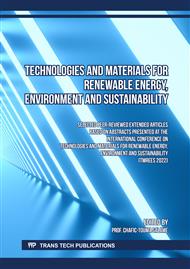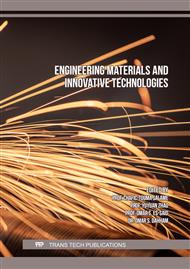[1]
Huang, H., et al., Stacking low carbon policies on the renewable fuels standard: Economic and greenhouse gas implications. Energy Policy, 2013. 56: pp.5-15.
DOI: 10.1016/j.enpol.2012.06.002
Google Scholar
[2]
Hertel, T.W., et al., Effects of US Maize Ethanol on Global Land Use and Greenhouse Gas Emissions: Estimating Market-mediated Responses. BioScience, 2010. 60(3): pp.223-231.
DOI: 10.1525/bio.2010.60.3.8
Google Scholar
[3]
Pattara, C., G.M. Cappelletti, and A. Cichelli, Recovery and use of olive stones: Commodity, environmental and economic assessment. Renewable and Sustainable Energy Reviews, 2010. 14(5): pp.1484-1489.
DOI: 10.1016/j.rser.2010.01.018
Google Scholar
[4]
Celma, A., S. Rojas, and F. Lopezrodriguez, Waste-to-energy possibilities for industrial olive and grape by-products in Extremadura. Biomass and Bioenergy, 2007. 31(7): pp.522-534.
DOI: 10.1016/j.biombioe.2006.08.007
Google Scholar
[5]
García-Maraver, A., et al., Analysis of olive grove residual biomass potential for electric and thermal energy generation in Andalusia (Spain). Renewable and Sustainable Energy Reviews, 2012. 16(1): pp.745-751.
DOI: 10.1016/j.rser.2011.08.040
Google Scholar
[6]
Miranda, T., et al., Characterization and combustion of olive pomace and forest residue pellets. Fuel Processing Technology, 2012. 103: pp.91-96.
DOI: 10.1016/j.fuproc.2011.10.016
Google Scholar
[7]
Abdulyekeen, K.A., et al., Torrefaction of biomass: Production of enhanced solid biofuel from municipal solid waste and other types of biomass. Renewable and Sustainable Energy Reviews, 2021. 150.
DOI: 10.1016/j.rser.2021.111436
Google Scholar
[8]
Marquina, J., M.J. Colinet, and M.d.P. Pablo-Romero, The economic value of olive sector biomass for thermal and electrical uses in Andalusia (Spain). Renewable and Sustainable Energy Reviews, 2021. 148.
DOI: 10.1016/j.rser.2021.111278
Google Scholar
[9]
Najafi, E., E. Castro, and K. Karimi, Biorefining for olive wastes management and efficient bioenergy production. Energy Conversion and Management, 2021. 244.
DOI: 10.1016/j.enconman.2021.114467
Google Scholar
[10]
Chakraborty, A., et al., Developing a spatial information system of biomass potential from crop residues over India: A decision support for planning and establishment of biofuel/biomass power plant. Renewable and Sustainable Energy Reviews, 2022. 165.
DOI: 10.1016/j.rser.2022.112575
Google Scholar
[11]
Kinab, E. and G. Khoury, Management of olive solid waste in Lebanon: From mill to stove. Renewable and Sustainable Energy Reviews, 2015. 52: pp.209-216.
DOI: 10.1016/j.rser.2015.07.094
Google Scholar
[12]
Giampieri, F., et al., Are by-products from beeswax recycling process a new promising source of bioactive compounds with biomedical properties? Food Chem Toxicol, 2018. 112: pp.126-133.
Google Scholar



